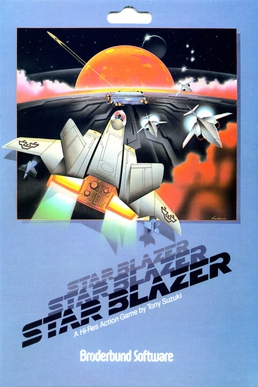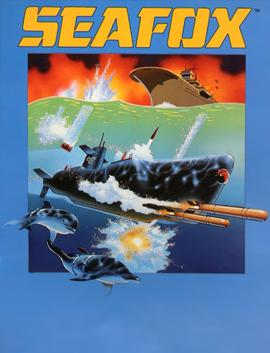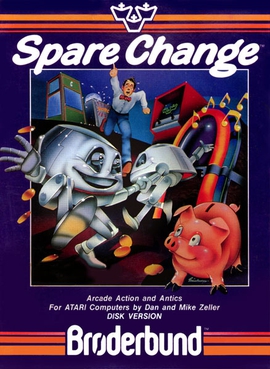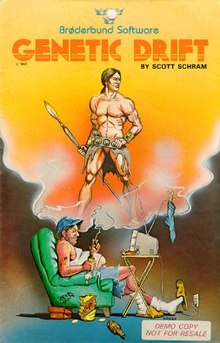
Miner 2049er is a platform game developed for Atari 8-bit computers by Bill Hogue and released by his company, Big Five Software, in 1982. The player controls Bounty Bob through multiple levels of a mine, with the goal of traversing all of the platforms while avoiding or defeating enemy mutants. At a time when "climbing games" such as Donkey Kong had four screens, Miner 2049er had ten.

Lode Runner is a 2D puzzle-platform game, developed by Doug Smith and published by Broderbund in 1983. Its gameplay mechanics are similar to Space Panic from 1980. The player controls a character who must collect all the gold pieces in a level and get to the end while being chased by a number of enemies. It is one of the first games to include a level editor.

Choplifter is a military themed scrolling shooter developed by Dan Gorlin for the Apple II and published by Broderbund in 1982. It was ported to Atari 8-bit computers the same year and also to the VIC-20, Commodore 64, Atari 5200, ColecoVision, MSX, and Thomson computers.
1982 was the peak year for the golden age of arcade video games as well as the second generation of video game consoles. Many games were released that would spawn franchises, or at least sequels, including Dig Dug, Pole Position, Mr. Do!, Zaxxon, Q*bert, Time Pilot and Pitfall! The year's highest-grossing video game was Namco's arcade game Pac-Man, for the third year in a row, while the year's best-selling home system was the Atari 2600. Additional video game consoles added to a crowded market, notably the ColecoVision and Atari 5200. Troubles at Atari late in the year triggered the video game crash of 1983.

Spelunker is a 1983 platform video game developed by Timothy G. Martin of MicroGraphic Image. It is set in a cave, with the player starting at the cave's entrance at the top, and the objective is to get to the treasure at the bottom.

David's Midnight Magic is a pinball simulation video game written by David Snider for the Apple II and published by Broderbund in 1982. The game was published in Europe by Ariolasoft. A port to Atari 8-bit computers was released the same year, then the Commodore 64 in 1983. In 1987 Atari Corporation published a cartridge version in the styling of the then-new Atari XEGS.

Apple Panic is a game for the Apple II programmed by Ben Serki and published by Broderbund Software in 1981. Apple Panic is an unauthorized version of the 1980 arcade game Space Panic, the first game with ladders and platforms. While the arcade original remained obscure, Apple Panic became a top seller for home computers. It was ported to the Atari 8-bit computers, VIC-20, IBM PC, and TRS-80.
Penguin Software was a computer software and video game publisher from Geneva, Illinois that produced graphics and application software and games for the Apple II, Macintosh, IBM PC, Commodore 64, Amiga, Atari 8-bit, and Atari ST computers. They produced the graphics programs Graphics Magician and Complete Graphics System, graphic adventure games such as the Transylvania series, arcade-style games like Spy's Demise, and role-playing video games such as Xyphus.
Synapse Software Corporation was an American software developer and publisher founded in 1981 by Ihor Wolosenko and Ken Grant. Synapse published application software and developer tools and was primarily known for video games. It initially focused on the Atari 8-bit computers, then later developed for the Commodore 64 and other systems. Synapse was purchased by Broderbund in late 1984 and the Synapse label retired in 1985.

Serpentine is a maze video game written by David Snider for the Apple II and published by Broderbund in 1982. Serpentine's gameplay and visuals are similar to the Konami arcade game, Jungler, released the previous year. It was ported to the Commodore 64 and Atari 8-bit computers. A VIC-20 version was licensed to Creative Software.

Karateka is a 1984 martial arts action game for the Apple II by Jordan Mechner. It is his first published game and was created while he was attending Yale University. The game was published in North America by Broderbund and in Europe by Ariolasoft. Along with Karate Champ and Yie-Ar Kung Fu, Karateka is one of the earliest martial arts fighting games. It was inspired by Japanese culture and by early Disney animated films and silent pictures. An influential game of its era, it was one of the first to use cinematic storytelling and sound design, and rotoscoped animation.

The Arcade Machine is a game creation system written by Chris Jochumson and Doug Carlston for the Apple II and published by Broderbund in 1982. Louis Ewens ported it to Atari 8-bit computers. Broderbund ran a contest from January–June 1984 where the best user-created game was awarded a prize of $1,500 in hardware and software. Jochumson also wrote Track Attack for Broderbund.

Gumball is a video game written for the Apple II by Veda Hlubinka-Cook and published by Broderbund in 1983. It was ported to the Atari 8-bit computers, and Commodore 64. The player controls the valves of a maze-like machine to sort gumballs by color.

Chronicles of Osgorth: The Shattered Alliance is a 1981 computer wargame published by Strategic Simulations in January 1982 for the Apple II and Atari 8-bit computers. Programmed by John Lyon, it relies on a new game engine, called RapidFire, intended to make faster and easier access to wargames published by the studio. During a turn, the program selects the units each in turn and the player only has to order them to move, attack or cast a spell. The order is then executed immediately before the program selects another unit. The game offers two categories of scenarios. The first is composed of medieval-fantasy confrontation, including a free adaptation of the Battle of Gondor against the Mordor forces in the Lord of the Rings. The second is composed of historical battles of antiquity.

Star Blazer is a horizontally scrolling shooter programmed by Tony Suzuki for the Apple II and published by Broderbund Software in 1982. A version for Atari 8-bit computers was released in 1983 as Sky Blazer.

Seafox is a shoot 'em up written by Ed Hobbs and published by Broderbund in 1982 for the Apple II and as a cartridge for Atari 8-bit computers. A VIC-20 port, also on cartridge, was released in 1983.

Spare Change is an action game designed by Dan and Mike Zeller and published in 1983 by Broderbund for the Apple II and Atari 8-bit computers. A Commodore 64 version was written by Steven Ohmert and released the same year. Ports for FM-7 and Sharp X1 were released in 1985. The difficulty of Spare Change can be customized through seven settings at the "Zerks Control Panel".

A.E. is a fixed shooter written by Jun Wada and Makoto Horai for the Apple II and Atari 8-bit computers and published by Broderbund in 1982. Versions followed for the VIC-20 (1983) and MSX (1984). Unlike most earlier shooters which have a solid color or starfield as a background, the action in A.E. takes place in front of science fiction scenes. Attacking creatures emerge from points in the image, often appearing to come from behind objects. Combined with a slight scaling as they advance, there is the impression of depth.

Labyrinth is a maze shooter written by Scott Schram for the Apple II, published in 1982 by Broderbund. It was ported to the Atari 8-bit computers by Corey Kosak.
















